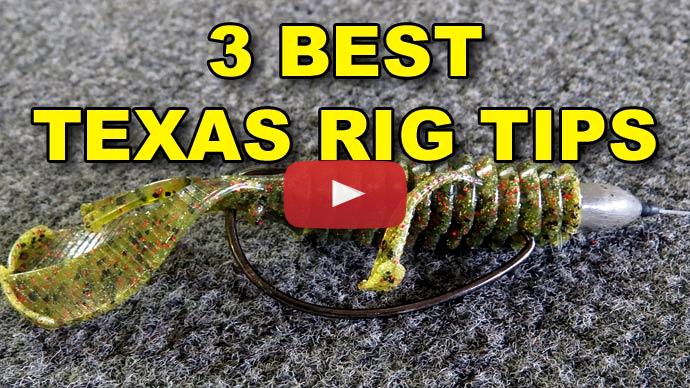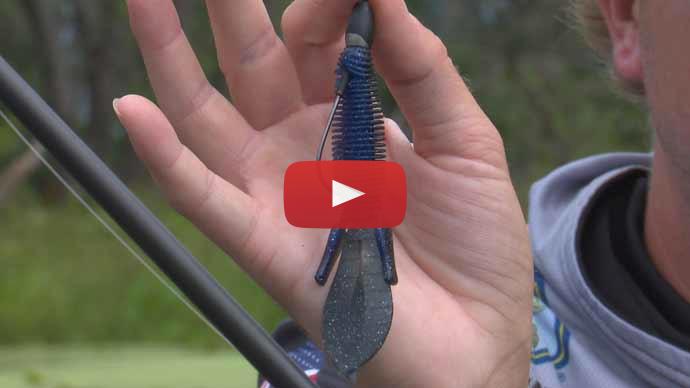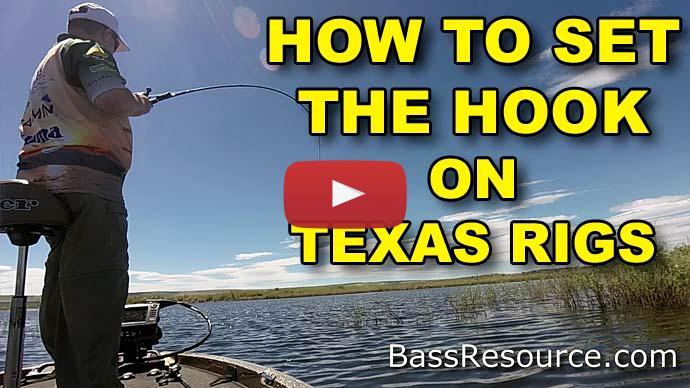Hey everyone, Mike McClelland, Major League Fishing pro here. And one thing that there always seems to be a little bit of confusion in my mind is when people talk Texas rigging. So many people pigeonhole Texas rigging into a specific rig made up of a bullet weight, and a hook with the bullet weight just sliding up and down your line. But in my opinion, when you talk Texas rigging, it is more about how you're actually rigging any specific piece of plastic on a hook. And the whole reason for that...and I mean, the simple reason it got its name is when bass fishing really kicked off years and years ago, Texas was a big time state for bass fishing. Texas lakes were full of brush and bushes and timber and weeds and all kinds of stuff.
So, the Texas rig was basically born in Texas, and essentially a Texas rig, no matter what kind of hook you use, I typically use a Gamakatsu hybrid worm hook, any Texas rigging I do, it's about how you rig your plastic on that particular hook.
So, what you're gonna do is you're gonna rig the plastic point-first, and you want it from the bottom facing the hook. You wanna go into your plastic about an eighth to a quarter of an inch, thread that plastic up over the keeper of the hook, and then you're basically gonna rig this hook in the plastic. So, it is weedless, hence the name Texas rig because of all the brush and weeds and everything grass that Texas had in their lakes. So, that is my definition of a Texas rig.
So, when you start talking Texas rigging, it is probably still today one of the most effective ways to catch a bass throughout the entire season of the year. I mean, we'll just start with the spring, for example. I mean, when you start talking springtime fishing, no matter what type of lake you're going to, there are gonna be opportunities to Texas rig a bait in a lot of different manners. Typically, when I go to a lake, the first thing I'm wanting to do in the spring is, I'm trying to develop a pattern that I can cover a lot of water doing. And one of my favorite ways of covering a lot of water, throwing a Texas rig in the spring, is gonna be with a Tour Series swim worm.
Once again, I'm gonna Texas rig that Tour Series swim worm, typically on anywhere from a 3/16, probably up to a 3/8 ounce weight like you see here. And I mean, basically what I'm gonna be doing with this Tour Series swim worm is I'm gonna be throwing it around any available cover. I can fish it swimming it through the water column, or I can actually fish this Texas rig up and down off the bottom. If I'm fishing around vegetation, I can wind it through the vegetation, drop it down into the holes. And there's a lot of different ways that you can cover a lot of water. You can throw this bait around stumps, laydowns, vegetation, anything you want to throw it around, a Texas rig gives you the opportunity to do that.
Another thing that becomes really a big deal in the spring, when you're talking Texas rigging, is flipping and pitching. And that is when I'm gonna incorporate baits like a Big Bite Fighting Frog, for example. Pitching a Big Bite Fighting Frog around laydowns, around, you know, bushes, in scattered vegetation around boat docks, a variety of different things. There's just so many different ways and so many different baits that you can utilize to Texas rig in the spring.
As far as springtime baits, I'm typically trying to throw baits that mimic crawfish, that mimic bluegill, and in some scenarios, something that might mimic a shad. You know, something like a Jerk Minnow, something like a jerk bait, something that you can throw around weightless on a Texas rig, you know, on the edge of grass, around willow trees, things of that nature. Those are gonna be the style baits that I'm looking to use in the springtime.
When you start talking rigging setups for springtime, whether I'm throwing a Tour Series swim worm, whether I'm pitching or flipping a Big Bite Fighting Frog, a Kamikaze Craw, a number of different baits. I mean, there's one pretty standard rule of thumb in my opinion. I'm always gonna be using fluorocarbon, Sunline Fluorocarbon, either in Shooter or Sniper, and I'm gonna match the line size according to the type of cover I'm fishing. I mean, in the springtime, if I'm fishing heavy cover, you know, bushes, a lot of timber, cedar trees, you know, anything that's thick and heavy in nature, I'm gonna generally be throwing 18 to 20 to 22 pound test Sunline Shooter or Sniper Fluorocarbon. If I'm fishing, you know, more sparse, scattered cover, then I don't feel so bad about throwing 14 or 16, maybe even 18 pound test Sniper or Shooter.
But the biggest thing about it is I want to, again, adjust my slip sinker, my weight according to the depth range and where the fish are positioned. You know, I may start with a 3/16, work my way up to 1/4 or 3/8, depending on how deep those fish are, and what depth range they want to be in, and how aggressive they are. So, you really gotta play with different size weights. I generally am always gonna be using a 3/0 or 4/0 hybrid worm hook on any of those setups, whether I'm pitching or flipping, you know, just scattered cover, I'm gonna be using a hybrid worm hook. But if I get into those situations where I'm, you know, flipping heavy vegetation, matted vegetation, things like that, that's when I'm gonna go to that punch weight, a bait like, you know, a Big Bite College Craw, something that's a little more subtle, something that's a little more of a bite size bait for those fish to get to.
So, those are the things, back to the line, when I'm punching in the early spring, I'm always gonna be punching braid. Sometimes I will drop down to 30 if I get into those lighter vegetation situations, but generally it's always gonna be 50 to 65 pound FX braid.
So, another thing when you're talking springtime Texas rigging that I think gets overlooked by a lot of people is just simply the fact when you get into those situations where you have cold fronts pass through during that springtime period when those fish are starting to stage, when they're starting to want to get up there and spawn, a lot of times during a cold front situation, those fish are going to move to the thickest cover they can find. Now whether that thickest cover is, you know, vegetation or flooded bushes, flooded willow trees, in some manner, those fish are gonna try to tuck up into the thickest cover they can. And that's where a bait, like a punched Texas rig bait is really key.
Generally, when I'm punching, especially vegetation, heavier bushes, really thick willow trees, I'm gonna use a half, three-quarter, one-ounce Gamakatsu punch weight. Whenever I'm punching, I am also going to change my hook style. I'm gonna use a Gamakatsu flipping hook, just a straight shank. I'm typically going to use the finesse version of that, heavy cover finesse, and I'm gonna rig that bait as well, Texas rigged. I've got a punch skirt on this to just give the bait a little bit more pizazz and flair, punching a little Big Bite College Craw on that bait as well.
So, that's probably the biggest thing about springtime Texas rigging is, you know, look for those areas where fish are gonna be transitioning, areas where you've got deeper water adjacent to spawning areas.
Points are something that I really focus on when I start to look for fish in the spring, but it, as you get closer to that spawning period of the time, you wanna start working your way back into the pockets, into the spawning areas, and that's when the fish will really start showing up around those types of cover I was talking about.
You know, if you've got lakes with vegetation, vegetation is a real strong key, generally the inside and the outside lines of the vegetation. If you've got a lake that floods in the spring, one of the biggest things that you really need to keep in mind is you want to put yourself in areas of that lake where you can actually get to the bank.
I know that so many times when I'm fishing in the springtime, and you get a big rise on a lake like we have in the Midwest, there at Table Rock for example, the lake floods and there's just miles of flooded bushes, flooded trees, and it really becomes kind of like picking a needle out of a haystack. But if you'll really focus on the areas where there's fewer trees, places like, you know, state parks, places that people actually clear their yards, where you've got isolated cover, isolated boat docks and things like that, you're gonna be a lot more successful catching fish on a Texas rig in the spring.



